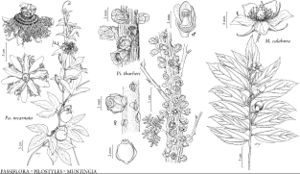familyMuntingiaceae
genusMuntingia
Show Lower Taxa
Muntingia
Sp. Pl. 1: 509. 1753.
Gen. Pl. ed. 5, 225. 1754.
Introduced
Etymology: For Abraham Munting, 1626 – 1683 Dutch botanist
Treatment appears in FNA Volume 6. Treatment on page 185.
| Taxon | Illustrator ⠉ | |
|---|---|---|
 | Passiflora incarnata Pilostyles thurberi Muntingia calabura | Linny Heagy John Myers Linny Heagy |
Leaves: blade lanceolate to lanceolate-linear, marginal teeth irregular, abaxial indument more ovary obscurely stipitate, subtended by ring of setiform hairs. Berries red [yellow]. Seeds yellowish, plumply lenticular. x = 15.
Distribution
Introduced; Fla., Mexico, West Indies, Central America, South America, also in Old World Tropics
Discussion
Species 1.
Muntingia is widely grown in warm to hot climates for fruit, fiber, and firewood.
Selected References
None.
Lower Taxa
... more about "Muntingia"
asymmetric +
connate +
veined +
lanceolate;lanceolate-linear +
distinct +
baccate +
spheric +
mixed +
setiform +
true +
absent +
alternate +
serrate +
irregular +
absent +
stipitate +
superior +
caducous +
distinct +
yellowish +
100;200 +
lenticular +
valvate +
caducous +
Introduced +
10;75 +
5;7 +
decurrent +
supra-axillary +
hairy +
Muntingia +
Muntingiaceae +
genus +
branched +
tangled +
stellate +
setiform +